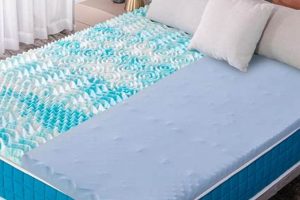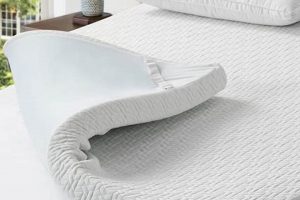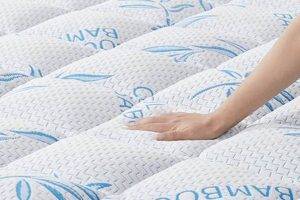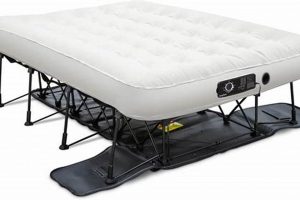This bedding accessory, designed for a single bed, features an additional layer of cushioning sewn onto the top surface. This supplementary padding, often constructed from materials like memory foam, down alternative, or fiberfill, is intended to enhance the comfort and support of the underlying mattress. As an example, an individual seeking to improve the softness of a firm mattress might consider adding this type of topper.
The principal advantage lies in its ability to modify the feel of an existing sleep surface without the expense of replacing the entire mattress. Historically, adding layers to bedding for improved comfort dates back centuries, but the modern iteration offers a readily available and relatively inexpensive method for customizing sleep experience. Its benefits include improved pressure relief, potentially alleviating aches and pains associated with inadequate support. Moreover, it can prolong the lifespan of a mattress by absorbing wear and tear.
The following sections will delve into various aspects of this product, including factors to consider when selecting one, the range of materials used in their construction, and guidance on proper care and maintenance to ensure longevity. Additionally, the analysis will cover common issues and troubleshooting tips to optimize the sleep experience.
Selection and Maintenance Guidelines
The following guidelines offer insight into selecting and maintaining a bedding enhancement specifically designed for a twin-sized bed. Adherence to these recommendations can optimize product performance and extend its usable lifespan.
Tip 1: Assess Mattress Condition: Before purchasing, evaluate the underlying mattress. If the mattress is excessively worn or damaged, a topper may offer limited improvement. Addressing underlying issues is paramount.
Tip 2: Consider Material Composition: Options include memory foam, latex, and fiberfill. Memory foam conforms closely to the body, while latex offers more responsiveness. Fiberfill provides a budget-friendly, less conforming alternative. Select based on preferred sleep feel.
Tip 3: Evaluate Density and Thickness: Higher density materials generally offer greater support and durability. Thickness impacts the degree of comfort enhancement. Balance thickness with support requirements.
Tip 4: Check for Secure Attachment: Toppers should securely attach to the mattress. Elastic straps or fitted designs prevent slippage and maintain consistent positioning during sleep.
Tip 5: Inquire About Warranty: A reputable manufacturer typically provides a warranty against defects in materials and workmanship. Review the warranty terms carefully before purchase.
Tip 6: Employ Regular Cleaning Practices: Follow manufacturer cleaning instructions. Spot clean spills promptly. Consider using a mattress protector to minimize staining and prolong lifespan. Vacuuming can also help maintain cleanliness.
Tip 7: Rotate Periodically: Rotating the topper can help distribute wear evenly, potentially extending its useful life. The frequency of rotation will depend on individual use and wear patterns.
These tips provide a foundation for making informed decisions regarding the selection and care of a bedding enhancement, ultimately contributing to improved sleep quality and product longevity.
The subsequent sections will explore common issues encountered with this type of bedding accessory and offer solutions to address those challenges.
1. Enhanced Comfort
The integration of “enhanced comfort” into a bedding accessory designed for a twin bed is a core design element and primary consumer expectation. The presence of an additional cushioned layer directly affects the user’s tactile experience. This layer functions as a buffer between the sleeper and the typically firmer support core of the mattress. For example, an individual experiencing pressure points due to a firm mattress might find substantial relief through the added cushioning. This comfort augmentation is achieved through materials specifically chosen for their softness and conforming properties, such as memory foam or down alternatives. Without this consideration for “enhanced comfort,” the product would be rendered largely ineffective, failing to address its fundamental purpose.
The practical application of “enhanced comfort” extends beyond mere subjective feeling. It influences sleep quality by minimizing disruptions caused by discomfort. Individuals who toss and turn due to pressure or inadequate support may experience fragmented sleep patterns. The integration of the cushioned layer aims to mitigate these issues. The effectiveness of the design hinges on a careful balance between softness and support, ensuring that the sleeper is comfortable without sacrificing proper spinal alignment. Selection of materials is essential; too much softness can lead to a lack of support, while insufficient cushioning negates the intended comfort benefits. Therefore, the design must consider the density and composition of the materials to achieve optimal results.
In summary, “enhanced comfort” is not merely a desirable attribute but rather an integral component of a product designed to improve sleep quality on a twin bed. Its presence dictates the product’s effectiveness in alleviating pressure points and minimizing sleep disruptions. The challenge lies in achieving a balance between softness and support, requiring careful consideration of material properties and design parameters to meet consumer expectations and deliver tangible improvements in sleep experience.
2. Pressure Relief
Pressure relief, in the context of bedding, refers to the reduction of concentrated force applied to specific areas of the body during sleep. Its connection to a bedding accessory designed for a twin bed is inherent to the product’s functionality. Without adequate pressure relief, individuals may experience discomfort, leading to restlessness and disrupted sleep patterns. The addition of a cushioned layer aims to redistribute body weight more evenly, thereby minimizing pressure points. For instance, someone who sleeps on their side may experience significant pressure on their shoulders and hips. A topper with effective pressure-relieving properties can alleviate this concentration of force, promoting better circulation and reducing the likelihood of pain or numbness.
The materials utilized in the construction directly impact its ability to provide pressure relief. Memory foam, known for its viscoelastic properties, conforms to the body’s contours, distributing weight across a larger surface area. Latex offers a similar effect, albeit with a more responsive feel. Fiberfill, while less conforming, can still provide a degree of cushioning that reduces pressure compared to a bare mattress surface. The effectiveness of the design depends not only on the material b
ut also on its density and thickness. A thicker, denser layer will generally offer more substantial pressure relief than a thinner, less dense one. Moreover, the design must ensure proper spinal alignment. If the cushioning is too soft and allows the body to sink excessively, it can compromise spinal support and potentially exacerbate pressure points in other areas.
In summary, the concept of pressure relief is fundamental to the benefits provided by this type of bedding accessory. Its effectiveness depends on the careful selection and configuration of materials to achieve a balance between cushioning and support. While the accessory cannot correct underlying spinal issues, it offers a relatively simple and cost-effective means to improve sleep comfort by mitigating pressure points and promoting more restful sleep. Understanding this connection allows individuals to make informed choices based on their specific needs and preferences.
3. Mattress Protection
The role of a bedding accessory in safeguarding the underlying mattress is a significant consideration for consumers. While comfort enhancement is often the primary motivation for purchase, the additional benefit of shielding the mattress from wear, stains, and other forms of damage contributes to its overall value.
- Barrier Against Spills and Stains
The topper acts as a primary defense against accidental spills of liquids, which can penetrate and damage the mattress core. Similarly, it provides a barrier against stains from body oils, sweat, or other contaminants. This protective function is particularly relevant in households with children or pets, where the risk of spills is elevated.
- Mitigation of Wear and Tear
Daily use inevitably leads to wear and tear on the mattress surface. The topper absorbs a significant portion of this wear, reducing friction and abrasion on the mattress itself. This can extend the lifespan of the mattress, delaying the need for costly replacement.
- Dust Mite and Allergen Reduction
Toppers can provide a degree of protection against dust mites and other allergens. While regular cleaning is still necessary, the topper acts as a removable and washable layer that can trap allergens before they reach the mattress core. This is especially beneficial for individuals with allergies or asthma.
- Maintaining Hygiene
By creating a barrier between the sleeper and the mattress, the topper helps to maintain a higher level of hygiene. Body oils, dead skin cells, and other debris accumulate on the topper rather than directly on the mattress. The topper can then be easily cleaned or replaced, preserving the cleanliness of the mattress.
These protective functions, while often secondary to comfort considerations, are nonetheless important factors in the decision-making process. The added benefit of prolonging the lifespan of the mattress and maintaining its cleanliness contributes to the overall value proposition of this type of bedding accessory.
4. Twin Bed Size
The dimensional compatibility between a bedding accessory and the bed frame it is intended for is paramount. In the context of a cushioned topper, the designation “twin” denotes specific measurements designed to precisely fit a standard twin-sized mattress. This dimensional congruence ensures proper functionality and aesthetic integration.
- Precise Dimensional Correspondence
The primary role of the “twin bed size” designation is to ensure that the topper accurately fits the dimensions of a standard twin mattress, which typically measures approximately 39 inches wide by 75 inches long. This prevents overhang, slippage, or insufficient coverage. An ill-fitting topper can compromise comfort and undermine its intended benefits. For instance, a topper too small would leave areas of the mattress exposed, while an oversized topper could bunch up and create uneven sleeping surfaces.
- Optimized Comfort and Support Distribution
A properly sized topper ensures uniform distribution of comfort and support across the entire sleep surface. If the topper does not adequately cover the edges of the mattress, the sleeper may experience inconsistent support, leading to discomfort and potentially affecting sleep quality. Proper fit is essential for maintaining a consistent feel throughout the bed.
- Secure Attachment Mechanisms
Many toppers utilize elastic straps or fitted designs to secure them to the mattress. These attachment mechanisms are designed based on standard twin mattress dimensions. An incorrectly sized topper might render these straps ineffective, resulting in slippage and movement during sleep. The secure attachment contributes to both comfort and safety, preventing the topper from shifting and creating potential hazards.
- Aesthetic Integration and Visual Appeal
Beyond functionality, the “twin bed size” designation contributes to the overall aesthetic appearance of the bed. A well-fitting topper creates a neat and visually appealing sleep environment. An ill-fitting topper can look unsightly and detract from the overall decor of the room. A tailored fit enhances the overall presentation of the bed.
In summary, the “twin bed size” designation is not merely a label but a critical element in ensuring the proper functionality, comfort, and aesthetic integration of a cushioned topper. Accurate dimensional correspondence is essential for achieving the intended benefits and maintaining a high-quality sleep experience.
5. Material Variety
The assortment of materials employed in the construction of a bedding accessory significantly influences its performance characteristics and suitability for individual preferences. In the context of a cushioned topper designed for a twin-sized bed, understanding material variety is crucial for making informed purchase decisions.
- Memory Foam Composition
Memory foam, a polyurethane-based material, is commonly utilized for its viscoelastic properties. It conforms closely to the body, distributing weight and reducing pressure points. Density variations impact firmness and support. High-density memory foam offers enhanced support and durability but may retain more heat. Open-cell memory foam is designed to improve airflow and reduce heat retention. In the context of a twin-sized topper, memory foam can provide targeted pressure relief for single sleepers.
- Latex Formulation
Latex, derived from rubber trees or produced synthetically, offers a responsive and resilient alternative to memory foam. Natural latex is hypoallergenic and breathable, making it suitable for individuals with sensitivities. Synthetic latex provides similar benefits at a lower cost. The firmness and density of latex also affect its support characteristics. A twin-sized topper constructed from latex can offer a balance of comfort and support with increased breathability compared to memory foam.
- Fiberfill Construction
Fiberfill, typically composed of polyester or other synthetic
fibers, provides a budget-friendly cushioning option. Fiberfill toppers are generally less conforming than memory foam or latex but can still enhance comfort and provide a degree of mattress protection. The loft and density of the fiberfill impact its cushioning properties. A twin-sized topper filled with fiberfill offers a cost-effective means to improve the feel of a firm mattress. - Down Alternative Fill
Down alternative, usually made of synthetic materials that mimic the properties of natural down feathers, offers a hypoallergenic alternative with good loft and cushioning. Toppers using down alternative can be comfortable and cost-effective, but tend to compress more readily than memory foam or latex. A twin-sized topper using down alternative provides a cruelty-free and allergy-friendly option, while adding a layer of softness to the bed.
The choice of material for a cushioned topper designed for a twin bed hinges on individual preferences regarding comfort, support, and budget. Memory foam provides conforming pressure relief, latex offers responsiveness and breathability, fiberfill presents an economical cushioning solution, and down alternative gives a hypoallergenic option with good loft. Evaluating these material characteristics in relation to specific needs ensures a satisfactory purchase.
6. Secure Fit
The concept of “Secure Fit” in relation to a cushioned topper designed for a twin mattress addresses the critical need for stable positioning during use. A topper that shifts or slides compromises comfort, support, and safety. Therefore, secure fit mechanisms are integral to its effective design and functionality.
- Elastic Strap Integration
Elastic straps are commonly employed to anchor the topper to the mattress. These straps typically attach to the corners of the topper and stretch around the mattress edges. Proper tension is essential; straps that are too loose offer inadequate securement, while excessively tight straps can cause bunching or distortion of the topper. The positioning and durability of the elastic are key to long-term effectiveness, preventing slippage due to movement during sleep. For instance, a user with a restless sleeping style will particularly benefit from securely fitted corners.
- Fitted Sheet Design
An alternative design incorporates a fitted sheet-like construction, where the topper has deep pockets that encase the mattress. This design provides a more comprehensive securement than elastic straps alone. The depth of the pockets must be compatible with the thickness of the mattress to ensure a snug fit. A fitted design minimizes shifting and bunching, resulting in a smoother and more consistent sleep surface. Proper fitment creates more surface area, decreasing the chances of movement.
- Non-Slip Backing Materials
Certain toppers incorporate non-slip materials on the underside to enhance grip against the mattress surface. These materials, such as textured rubber or silicone, create friction that resists lateral movement. Non-slip backing can be particularly effective on smooth mattress surfaces where straps or fitted designs may be less reliable. The durability of the non-slip material is crucial, as wear and tear can reduce its effectiveness over time. This method also improves pressure point distribution.
- Zippered Encasement Systems
While less common for simple mattress toppers, some advanced designs feature a full zippered encasement. In these systems, the topper fully envelops the mattress like a protective shell, ensuring a completely secure fit and preventing any shifting or sliding. This design offers the highest level of securement but may be more difficult to install and remove. This method works best with lightweight mattresses.
In summary, the “Secure Fit” attribute, achieved through various means, contributes significantly to the overall performance and user satisfaction of a cushioned twin mattress topper. The choice of securement mechanism depends on the design, materials, and intended usage, but the ultimate goal remains constant: to provide a stable and consistent sleep surface by preventing unwanted movement and ensuring proper alignment with the underlying mattress.
7. Cost-Effective
The concept of “Cost-Effective” is central to the appeal of a cushioned topper designed for a twin-sized bed. This attribute reflects its ability to provide substantial improvements in sleep quality and mattress longevity at a price point significantly lower than that of a new mattress.
- Extended Mattress Lifespan
A primary mechanism for cost savings lies in the topper’s protective function. By absorbing wear and tear, the topper reduces stress on the underlying mattress, prolonging its useful life. The cost of replacing a mattress far exceeds the investment in a topper, making this a significant economic consideration. For example, a mattress that might otherwise need replacement after five years could potentially last seven or more with the consistent use of a topper, representing a tangible cost saving.
- Affordable Comfort Enhancement
A topper offers a budget-friendly alternative to purchasing a new, more comfortable mattress. Individuals seeking to improve the feel of their current sleep surface can achieve significant gains in comfort without incurring the substantial expense of a complete mattress replacement. This is particularly relevant for those on a limited budget or for temporary sleeping arrangements, such as guest rooms or dormitories. The difference in cost can be hundreds, or even thousands, of dollars.
- Reduced Need for Specialized Mattresses
Certain individuals require mattresses with specific features, such as enhanced support or pressure relief, to address medical conditions or physical discomfort. A topper can sometimes provide a similar level of comfort and support, reducing the need for a more expensive, specialized mattress. For example, a person with mild back pain might find sufficient relief from a memory foam topper, avoiding the need for a costly orthopedic mattress.
- Versatility and Adaptability
The adaptability of a topper to different sleeping preferences further enhances its cost-effectiveness. A single topper can be used to modify the firmness or softness of a mattress, accommodating changing needs or preferences over time. This versatility eliminates the need to purchase multiple mattresses to suit different sleep styles or physical conditions. As needs change, the topper may be exchanged or adjusted, preserving the use of the original mattress.
In conclusion, the cost-effectiveness of a cushioned topper designed for a twin-sized bed stems from its ability to extend mattress lifespan, provide affordable comfort enhancement, reduce the need for specialized mattresses, and offer versatile adaptability. These factors contribute to a compelling value proposition for consumers seeking to improve their sleep experience without incurring excessive expense.
Frequently Asked Questions
This section addresses common inquiries regarding bedding accessories designed to enhance comfort on twin-sized mattresses. Information presented aims to clarify usage, maintenance, and expectations associated with these products.
Question 1: What dis
tinguishes a twin mattress topper from a standard mattress pad?
A mattress topper is typically thicker and designed to significantly alter the feel of the mattress, providing added comfort and support. A mattress pad is generally thinner and primarily intended to protect the mattress from stains and minor wear.
Question 2: How does the thickness of a twin size pillow top mattress topper affect sleep quality?
Increased thickness generally provides greater cushioning and pressure relief. However, excessive thickness may compromise support, potentially leading to spinal misalignment. Balancing thickness with support requirements is essential for optimal sleep quality.
Question 3: Can a twin size pillow top mattress topper correct an old or damaged mattress?
While a topper can improve comfort and mask minor imperfections, it cannot fully correct significant damage to an underlying mattress. If the mattress is severely worn or sagging, replacement is generally recommended for proper support.
Question 4: What are the common maintenance procedures for a twin size pillow top mattress topper?
Regular vacuuming is recommended to remove dust and allergens. Spot cleaning should be performed promptly to address spills. A mattress protector can further safeguard the topper from stains and wear. Consult manufacturer instructions for specific cleaning guidelines.
Question 5: How does the material composition of a twin size pillow top mattress topper influence its performance?
Memory foam conforms to the body and provides pressure relief. Latex offers responsiveness and breathability. Fiberfill provides budget-friendly cushioning. The choice of material depends on individual preferences and specific needs.
Question 6: What factors should be considered when selecting a twin size pillow top mattress topper for a child?
Prioritize hypoallergenic materials and easy-to-clean surfaces. A secure fit is essential to prevent slippage. Consider a lower profile to maintain stability and minimize the risk of falls. Proper fit is also essential.
These FAQs provide a foundational understanding of twin mattress toppers. Selecting the appropriate product and adhering to proper maintenance practices contributes to enhanced sleep quality and product longevity.
The following section will delve into common issues and troubleshooting tips associated with twin size pillow top mattress toppers, offering practical solutions for optimal sleep experiences.
Conclusion
This exploration of the pillow top mattress topper twin has illuminated its multifaceted nature, encompassing its role in comfort enhancement, mattress protection, and cost-effective sleep solutions. The analysis of materials, secure fit mechanisms, and maintenance considerations underscores the importance of informed decision-making in selecting and utilizing this bedding accessory. From understanding the nuances of memory foam to appreciating the significance of dimensional compatibility, this discussion has aimed to provide a comprehensive overview.
The selection and proper care of a pillow top mattress topper twin can significantly impact the quality of rest and the longevity of a mattress. As sleep remains a critical component of overall well-being, continued attention to the factors outlined herein will contribute to optimizing the sleep experience for individuals utilizing twin-sized mattresses.







